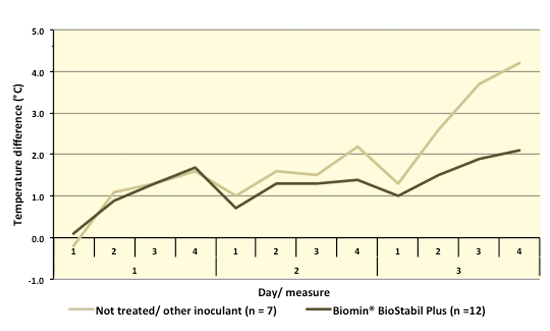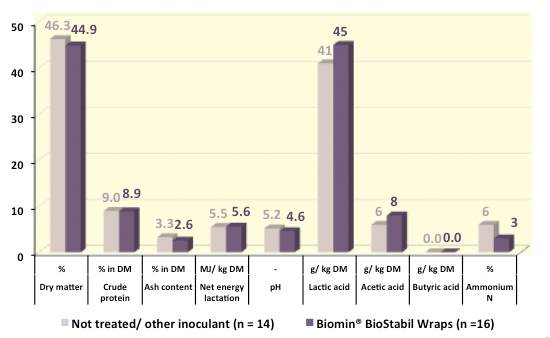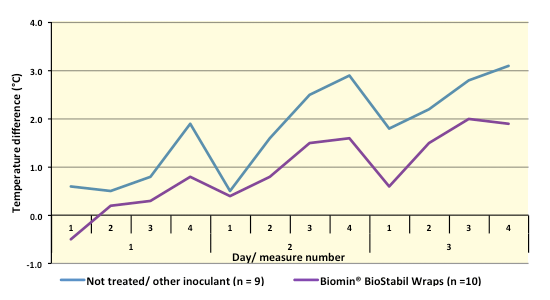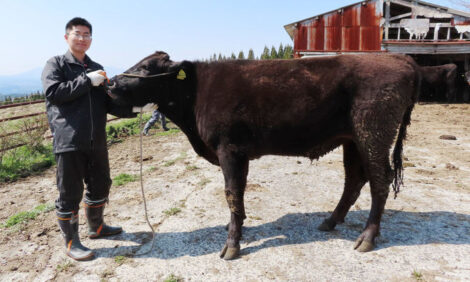



How to Produce High-Quality Grass Silage
Grass silages represent a low-cost feed which can be distributed during the winter time, according to Biomin. The process of making grass silage is repeated three to four times every year in the same areas. Due to the rapid growth of the grass there is usually an excess of biomass in summer which can be ensiled at relatively low costs, if properly made.As the yield of cow’s milk has increased enormously in recent years and therefore their nutritional requirements have also increased, and the capacity of the rumen is limited, it is not enough to merely produce silage; it must be high quality silage. High quality grass silages can be characterised by the different parameters listed below
Grass silage quality
Nutrient and energy content:- Dry matter (DM): 30 – 45 per cent
- Crude protein: < 17 per cent
- Crude fiber: 22 – 25 per cent
- Crude ash: < 10 per cent
- Net energy for lactation: 6.0 – 6.4 MJ/ kg DM
- pH value: 4.0 – 5.0 (depending on DM content)
- butyric acid: optimal value = 0.0 per cent in DM
- acetic acid: 1.5 – 3.0 per cent in DM
- ammonium N: < 8.0 per cent
- Yeasts: < 1,000,000 cfu/g of silage
- Molds: < 5,000 cfu/g of silage
How to reach a high quality in grass silages
High quality is not a phenomenon which occurs per se. Grass, compared to corn, has a relatively low sugar and high protein content entailing a higher buffering capacity, which deteriorates the fermentability. Also, the cut height (five to seven cm vs. 20 – 30 cm in grass and corn respectively) increases the risk of contaminations with soil and therefore Clostridia.
Some key recommendations for achieving high quality grass silages are presented in the following paragraphs:
- Adequate harvest time (30 – 45 per cent of DM): At this stage of maturity the plant has a good balance between sugar and buffering capacity, as well as acceptable raw fiber content. Below the given optimal DM content there is an increased risk of Clostridia contamination, as well as higher losses due to effluents. Higher DM content is a sign of high fiber content and makes compaction difficult. The optimal particle size in grass silages is less than four cm. There is a rule to assure a good compaction: the higher the DM, the shorter the particle length.
- Low contaminations with soil (ash content below 10 per cent): the risk is higher if the silage is relatively wet (< 25 per cent of DM). If this is the case, a higher cut height (seven to eight cm) is recommended.
- Compaction (> 650 kg/m3): the most important operation in processing silage is the compaction. The whole technological process should be adapted to the capacity of the compacting machines. Some references: compact no more than one ton of DM/ hour/ ton of machine weight. From a practical point of view, if the machine weighs 10 tons and the DM content is 40 per cent, do not fill the silo with more than 25 tons of material/ hour. It is possible to increase the weight of the machinery by putting water in the wheels or using cement blocks fixed on the tractor. Each extra kg of weight improves silage quality.
- Covering: under optimal conditions, the material should be ensiled and covered on the same day. However, in some cases the filling time exceeds 24 hours. It is recommended that the filling time should not exceed 72 hours. Once the silo is filled, cover immediately with suitable plastic sheets and ensure they are fixed using proper weights (tyres, soil or sand bags). A good compaction and an adequate cover keep the silage stable for longer periods of time, until the silage is actually used. Furthermore, these factors prevent the growth of mold, and therefore further mycotoxin production.
- Inoculation: silages outside of an adequate DM range (25 – 45 per cent) should be treated with chemical products to obtain the desired effect. Wet or dirty grass should be treated (for example, with sodium nitrite) to keep Clostridia under control, whereas dry silages should be treated (for instance, with propionic acid) to inhibit mold growth due to less efficient compaction. Inoculation represents a safer and less expensive alternative to acid/ salt treatments. As the main problem in grass silages is acidification, homolactic lactic acid bacteria (LAB) should be used. Nevertheless, a combination of homo- and heterofermentative LAB not only guarantees fermentation, but also better aerobic stability. The aerobic stability is at risk if compaction is inadequate; when the advance in the silo is not fast enough (25 and 50 cm/day in winter and summer respectively), due to relatively big silos and/or when the cut of the silage surface is uneven, amongst other factors. Inoculation enables better results.
Very often inoculants are seen as a “panacea”. When the above-mentioned key issues are adapted properly on the farm during the silage making process, the farmer can reach a higher silage quality, due to the use of inoculants (better fermentation, longer aerobic stability, and higher energy recovery). However, silage inoculants cannot correct errors in the silage processing. The results of using adequately designed silage inoculants are presented in the following paragraphs.
BIomin Solutions For a hIgher Grass Silage Quality and Better Performance
For years BIOMIN has been working to develop market- tailored solutions in the field of silage inoculants. In the case of grass silages, there is a differentiation in the product line, according to the silo which is used:
- For bunker silos and other types of silos with potential problems regarding aerobic stability (too wide, over dimensioned, etc.): Biomin® BioStabil Plus, a blend of hetero- and homofermentative bacteria for better fermentation, aerobic stability and higher DM, nutrient and energy recovery of the silages.
- For wrapped silages: Biomin® BioStabil Wraps, a blend of homofermentative bacteria, recommended for baled silages for better fermentation and DM, nutrient and energy recovery.
Results of using the Biomin® BioStabil silage inoculants:
The following results were collected and summarized from several field trials between 2008 and 2011, mainly in Central Europe, and are related to the quality of silages which were untreated, or treated with competitor products, vs. treatment with Biomin® BioStabil. The opening of the silos took place between four and six weeks after ensiling. Samples were collected and sent to the laboratories either by the owners of the farms or by the BIOMIN staff.
I - Biomin® BioStabil Plus:Diagram 1 shows parameters of silage quality from silages kept in bunker silos.
Diagram 1: Selected parameters of the silage treated or not treated with Biomin® BioStabil Plus

No marked differences in DM content were found (33.5 ± 1.5 vs. 34.9 ± 2.1 per cent for untreated silages/ other inoculants respectively). Therefore, a direct comparison is feasible. The crude protein and energy contents are higher in silages treated with Biomin® BioStabil Plus. This is closely related to the improved acidification of those silages. It should also relate to a deeper and faster acidification during the first week after the silo is closed. The lower pH value also corresponds to a higher production of lactic acid. Nevertheless, the differences in pH value are not more marked, because the high quantity of acetic acid (+50 per cent for Biomin® BioStabil Plus) influenced this parameter.
This was reflected in an improved aerobic stability (Diagram 2). The aerobic stability was measured at least four times a day (around 08:00, 12:00, 15:00 and 18:00) during the three to five days after the silos were opened. For this purpose, samples of the silages were taken, and then put in buckets and the silage, as well as the ambient, temperatures were recorded. As the duration of the test differed, the results are only presented up to the third day after the opening of the silo, and they are presented as the difference in comparison to the ambient temperature, to avoid differences which were due to different ambient conditions.
Diagram 2: Temperatures of silages treated or not treated with Biomin® BioStabil Plus

As shown above, the temperature increased markedly on the third day of the test for aerobic stability. It is a clear sign of a spoiling process occurring due to the conversion of energy and nutrients to alcohol in exothermic reactions caused by yeasts mainly.
II - Biomin® BioStabil Wraps:Fourteen round bales treated with products other than Biomin® BioStabil Wraps, or untreated, were compared to 16 round bales treated with Biomin® BioStabil Wraps. In Diagram 3 shows selected parameters of the silage quality (nutrient and energy content, as well as fermentation quality).
Diagram 3: Selected parameters of the silage treated or not treated with Biomin® BioStabil Wraps

The first difference, in comparison with the silages kept in bunker silos, is the higher DM content. This makes a big difference to composition and fermentation of the material because of the higher osmotic pressure in the plant juice. This is the reason why the pH value remained relatively high (over 4.5). However, the use of the silage inoculant led to a lower pH value (5.2 vs. 4.6 for Biomin® BioStabil Wraps). Clostridia fermentation does not appear to be a major problem in wrapped silages.
The temperatures of the silages treated with Biomin® BioStabil Wraps were lower from the very beginning. Even where the aerobic stability of the wrapped silages is not a major issue, the fact that those silages are consumed very quickly (within the first day after opening the round bale, or the advance in the bag is rapid and does not facilitate the growth of yeasts) is also a remarkable advantage in using Biomin® BioStabil Wraps.
Diagram 4: Temperatures of silages treated or not treated with Biomin® BioStabil Wraps

Conclusions
- Grass silages represent economic alternatives for feeding animals in periods of feed deficit
- There are rules which should be taken into account to reach high quality in grass silages
- The use of silage inoculants cannot rectify errors in the silage making process
- Through good ensiling practices, the use of silage inoculants like Biomin® BioStabil plus and Biomin® BioStabil Wraps can markedly improve:
- the nutrient and energy recovery,
- the acidification,
- the protection against Clostridia mainly in bunker silos, and
- the aerobic stability



